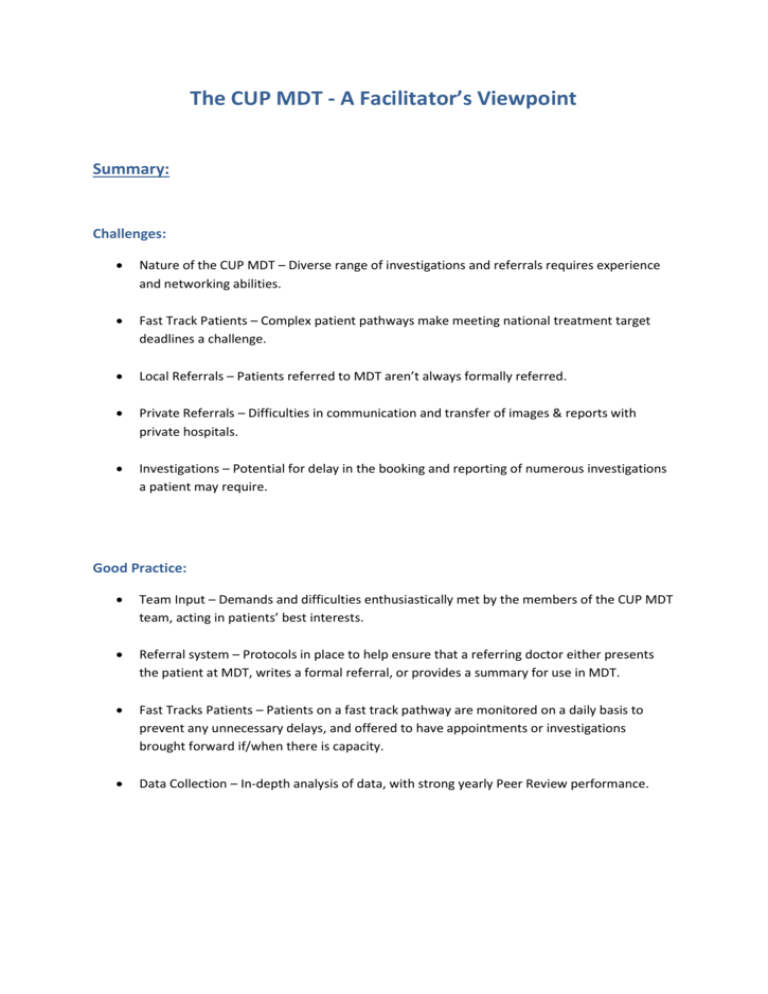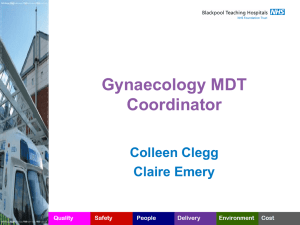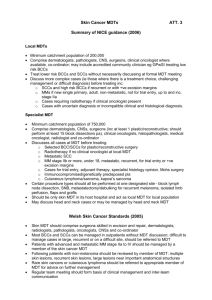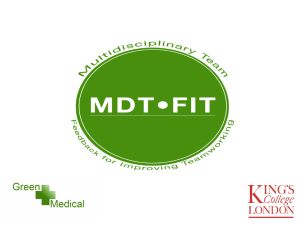MDT facilitator - Cancer of Unknown Primary (CUP)
advertisement

The CUP MDT - A Facilitator’s Viewpoint Summary: Challenges: Nature of the CUP MDT – Diverse range of investigations and referrals requires experience and networking abilities. Fast Track Patients – Complex patient pathways make meeting national treatment target deadlines a challenge. Local Referrals – Patients referred to MDT aren’t always formally referred. Private Referrals – Difficulties in communication and transfer of images & reports with private hospitals. Investigations – Potential for delay in the booking and reporting of numerous investigations a patient may require. Good Practice: Team Input – Demands and difficulties enthusiastically met by the members of the CUP MDT team, acting in patients’ best interests. Referral system – Protocols in place to help ensure that a referring doctor either presents the patient at MDT, writes a formal referral, or provides a summary for use in MDT. Fast Tracks Patients – Patients on a fast track pathway are monitored on a daily basis to prevent any unnecessary delays, and offered to have appointments or investigations brought forward if/when there is capacity. Data Collection – In-depth analysis of data, with strong yearly Peer Review performance. MDT Preparation: Below is a Sankey diagram showing the 2014 cohort of Poole patients that presented with bone mets (left), and their subsequent primary diagnosis (right), proportional to arrow thickness. The annotations in red list a range of investigations that may have taken place to lead to that respective primary diagnosis. (All other possible investigations) Thoracoscopy +/- Cytology Chest X-Ray(s), CT Chest EGFR, KRAS ERCP, MRCP CT Abdo, US Scan LFTs, CA 19-9 CT Abdo/Pelvis MRI Abdo/Pelvis US Scan Renal Function CA-125 Transvaginal USS CT Pelvis US Scan Physical Examination MRI Pelvis PSA FBC, Kidney + Liver Functions Myeloma Screen PET Scan The need for networking skills and experience is shown here on two accounts: The first to have to have the experience as a facilitator to be aware of relevant investigations to collate for the MDT meeting. Secondly, to have robust communication methods with other local, network or national/specialist MDT sites in the event a primary is found, or specialist advice is needed. Problems can arise when a patient is referred in from the Private Sector however, and communications & interactions don’t run as smoothly as they would between NHS Hospitals. It has been useful to keep a broad list of contacts with local private hospitals, especially their secretaries and radiology departments, as these people are often key to finding out if patients have had any scans or investigations privately. There are occasionally problems, and transfers of scans don’t always take place, and scans being sent without their formal reports can often occur. The only practical way around this so far has been to simply contact the hospitals and arrange for any transfers to be organised as soon as possible, so there is room for chasing up if needs be. Fast Track Patients: Tracking the pathway of MUO/CUP patients who have been referred by the GP via the Fast Track Pathway (a 62 day target starting from a referral being received from a GP, to treatment commencing) is a particularly hard site to monitor and prevent breaches. In other sites, for example Upper GI, the majority of patients that breach this target tend to do so due to the fact they had complex diagnostic pathways i.e. when they had investigations or staging procedures beyond that which are normally required. Any patient that is Fast Tracked to us and subsequently considered (at any point) to be a potential MUO/CUP patient is closely monitored, as they may require numerous investigations. From a facilitator point of view, this means working with departmental managers to expedite scans or chase histology reports for example. Poole 2014 Data – 37 new patients to CUP MDT, 24 underwent biopsy. Of those 24, 16 had their primary found, 8 were diagnosed cCUP (6 x adenocarcinomas, 1 x squamous cell carcinomas, 1 x other/sampling error). The majority of patients that pass through the MDT have a biopsy of some kind (see above charts). Biopsies are an area of potentially delay, as it must be booked and subsequently a histopathology report must be issued. If the primary cannot be identified at first inspection of the biopsy, sometimes further immunohistochemistry is performed on the sample to help do so. This can be a challenging feat to get this done in a short amount of time, especially when the patient is under a Fast Track pathway. Nevertheless, the team recognises the potential for delay and works to ensure we provide a smooth service with minimal delay. Referrals: The majority of additions to the MDT list go directly to the facilitator, typically via a phone call from a Doctor on a ward. A protocol we have in place in Poole is that if the patient is not known to any of the CUP MDT team, I usually ask that one of the following is done: i. ii. iii. Someone is able to present the patient in person at the MDT meeting. A formal referral is made to the oncology team. At the very least, a summary note is left on the electronic systems. Doing so simply ensures we can discuss the patient with as much information as possible. If they are an inpatient, the inpatient notes are collected immediately prior to the meeting for discussion, and returned straight after (with permission from the ward staff). Analysis of Data: MUO patient pathways are very unique as the majority of patients that come through the CUP MDT ultimately end up being managed by another MDT – roughly half of MUO patients that passed through the CUP MDT in 2014 had their primary found (19 out of 37 patients had their primary site found). Patient information is always recorded as soon as possible. Being a relatively small group of patients, it has been more manageable to then comprehensively analyse this data on a yearly basis, i.e. once a significant cohort of patients has built up. Doing so helped highlight areas of improved data collection, such as the recording of the locations of metastatic disease for each patient. Of course this could be taken even further (should the resources allow), such as recording the individual tumour markers that were raised in each patient, or the specific location of the individual bone metastases for example. A report of the CUP MDT is made on an annual basis (along with a review and update of the MDT’s operational policy and work programme). This is subsequently reviewed by the MDT team and finalised in preparation for the yearly peer review process. A Recent Example of a Complex Case: Below is a real example of a recent patient’s pathway at Poole Hospital. Every effort has been made to anonymise the patient. I feel this acts as a good example of how complex MUO/CUP patients can be to manage from an admin/facilitator point of view. The points are bulleted as the pathway unfolded. Patient referred into another local hospital by the GP under the Fast Track system. Metastatic disease discovered (pelvic mass + nodal) with no obvious primary found. Patient referred to Poole CUP MDT – notes and reports arranged for transfer to Poole. Patient monitored daily to prevent delay, in view of Fast Track status. Investigated extensively at Poole with scans and biopsies, along with multiple discussions at MDT – potential sources of primary refined, but no definitive source identified. Palliative Care Team involved. Patient diagnosed CUP and underwent targeted radiotherapy to metastatic disease. Information obtained from patient regarding having treatment for abnormal smear results 10+ years ago elsewhere in the UK. All main hospitals in the area were consequently contacted to investigate. One hospital confirmed records of the patient – initial delay due to the fact patient had a different surname and forename at time of registration with previous hospital. Records showed CINIII (‘pre-cancer’) on biopsy 10+ years ago. National specialist review of histology undertaken, and re-discussion at MDT in view of new information subsequently led to a primary diagnosis of a cervical cancer. Alex Osborne alex-osborne@hotmail.co.uk






